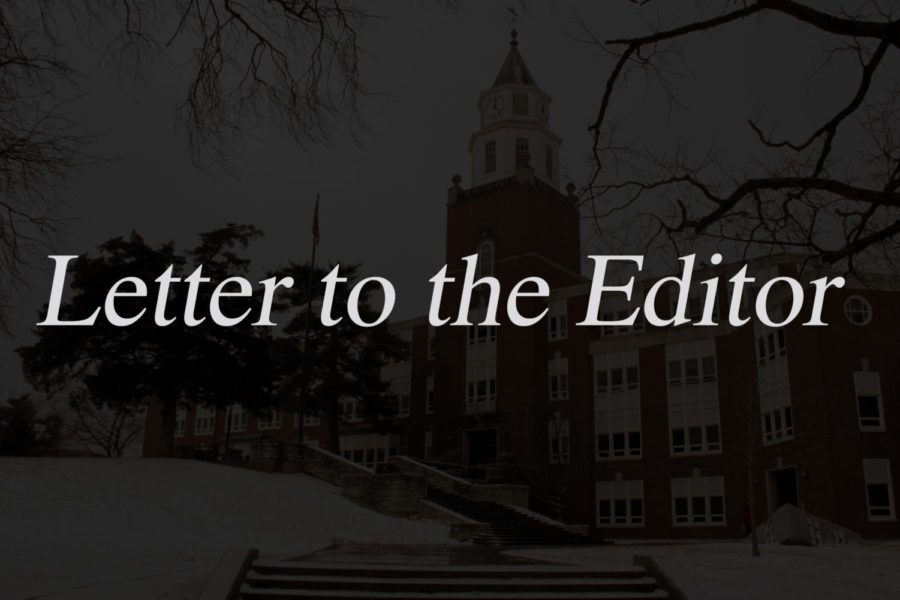Letter to the Editor: What you need to know about the board vote on academic reorganization ‘concept’
December 3, 2018
At the November 9th emergency Board of Trustees meeting, the Faculty Senate presented a draft resolution requesting that the Board engage in the “prompt approval of the SIUC reorganization process, so that (they) may continue with our reorganization efforts in a timely fashion.” Apparently, the Board was listening: at its upcoming December 13th meeting, the Board intends to vote on a matter which would settle the question of the reorganization once and for all.
While I appreciate the desire of the faculty of my alma mater and the Board of Trustees to put an end to the uncertainty surrounding the reorganization following the death of Chancellor Montemagno, I do not believe that the implications of this decision have been fully explained to the student body by the Board of Trustees or the Faculty Senate, nor do I believe that it was ever the intention of the Board of Trustees or the Faculty Senate to solicit student opinion where the reorganization is concerned.
If I might clarify the point: with exception to Trustee Lockett, who has clearly and explicitly made it his mission to serve as a bridge between the Board and the student body through his Campus Conversations series, I do not believe that the Board of Trustees considers it their responsibility to ensure students understand what will be done to their university should the Board impose this decision upon it.
Advertisement
Students, it seems, are to be seen and not heard regardless of their policy-given right to participate in conversations concerning the organization of their university.
If I am going to be true to my responsibility as an alumnus to ensure student success, I will not accept administrative assurances that “all is well” with the university, nor will I accept the disenfranchisement of student participation in the administration of their own university. It is for this reason that I am providing the student body with information concerning the implications of the decision that the Board will make on December 13th.
What will actually be voted upon?
As indicated by Board matter L-3 in the recently published Board of Trustees materials, the Board will vote to approve the following
1.The University’s reorganization as described by the board matter “and other materials provided or made available to the board over the past year,
2. The use of the IBHE’s recommended process of the Request for Reasonable and Moderate Extension in relation to enacting the administrative reorganization of academic units,
3.The authorization of Interim President Dorsey “to take whatever action may be required in the execution of this resolution in accordance with established policies and procedures.”
Advertisement*
Put simply: the resolution would approve the school-based reorganization as described by the Board and in the documents provided by the late Chancellor Montemagno. It would also delegate authority to Interim President Dorsey where all aspects of the execution of the reorganization is concerned, which would include approving or denying all proposals for the reorganization.
What does the reorganization look like?
The Board matter recommends that “the Board approves the University’s reorganization as described within this document and other materials provided or made available to the Board over the past year.”
To be clear: this would be a vote to approve the last version of the Vision 2025 plan released by the late Chancellor which includes the elimination of academic departments in favor of schools. This version was opposed by the Faculty Senate, the Graduate Council, GPSC and USG for a variety of reasons ranging from opposition to the elimination of all academic departments, to the specific locations of units under the proposed Vision 2025 plan.
Moreover, approving the Vision 2025 plan, with its emphasis on the elimination of departments in favor of schools, would likely result in the immediate rejection of any faculty generated plan that did not include the elimination of departments. This would be something of an immediate change in direction for the reorganization under Chancellor Montemagno who encouraged the submission of faculty driven proposals, even if they did not align with the Vision 2025.
Should the Board move forward with approving the Vision 2025 plan, in spite of the opposition of campus constituency groups, the Board would be very clearly communicating to the campus that it has no interest in processes of shared governance where the organization of the university is concerned; and, it would be making abundantly clear that it simply has no interest in the concerns of the campus community where the future of the university is concerned except where those concerns align with its vision of the university.
This would be the worst of all possible solutions.
What is this IBHE recommended process the resolution refers to?
Every new school requires an RME for every program which will be housed within that school. In the case of some schools, the number of RMEs can range from three to six, which would result in the IBHE possibly receiving large numbers of RMEs simultaneously for consideration. Further, given that submitting RMEs is possible only after the RME has moved through campus approval processes, many RMEs will be submitted at different times, which leads to an inconsistent approval timeline where specific schools are concerned.
Thus, given the scope of the reorganization, the inconsistency in approval timelines for individual RMEs, the sheer number of RMEs, and the workload that these RMEs would place upon the IBHE, the IBHE opted to direct the Board of Trustees to submit a reorganization “concept” for approval, rather than individual RMEs, so that the campus could proceed with the reorganization as a whole.
The Board matter would override the process of individual submissions for approval by the Board and enable the Board to approve the reorganization wholesale, specifically insofar as the IBHE has requested that the university provide a comprehensive reorganization plan. As the IBHE does not require campus level approval of the reorganization, it is possible that the Board could impose upon the campus a reorganization that is not approved by all campus stakeholders.
What does it mean that the Interim President is authorized to “take whatever action may be requires in the execution of this resolutions?”
At its most basic, this resolution would grant Interim President Dorsey sole authority to execute any action he deems necessary to expedite the proposed reorganization. However, the resolution also makes specific mention to Policies of the Board B(2) and Article III, Section 2 of he Statutes, which delegates authority to the President of the Board to approve changes to programs “which do not effectively increase the number of units of instruction, research or public service.”
What this means is that Interim President Dorsey, not the campus level administration, or the Board of Trustees itself, will be the sole individual responsible for approving elements of the reorganization. Moreover, as the “the University’s reorganization as described within this document and other materials provided or made available to the Board over the past year,” refers only to the late Chancellor Montemagno’s school-based reorganization, it is assumed that all proposals that do not align with the school-based model will be rejected.
Is there a precedent for this?
There are multiple precedents for approving the reorganization in this way, though not all of them map neatly onto the current situation.
As an example, the Board has provided tacit approval of numerous “strategic plans” including the ill-fated “Saluki Way” and “Southern at 150,” both of which emerged from quasi-extensive review processes that took up the results of the last Higher Learning Commission review as well as the results of campus wide committees. While neither “Saluki Way” nor “Southern at 150” delivered on their promises, neither could proceed without tacit or explicit approval of some of their elements by the Board of Trustees.
A much better example would be the development of the Financial Sustainability Plan (FSP) from the reports of the Academic and Non-Academic Program Prioritization Committees, which advocated for specific kinds of programmatic change without seeking broad campus input. While the plan itself was developed from the two reports generated by these committees, and thus included some campus input, the completed plan was submitted to the Board for approval without a thorough vetting by the campus community.
The FSP is probably the better example to rely upon for a precedent given that it included recommendations for the merger, elimination, and closure of programs, departments, and colleges. Moreover, the FSP was used as justification by the late Chancellor Montemagno for the implementation of some of the early stages of his reorganization. As the Board had already approved the FSP’s recommendations, the Chancellor did not need to seek Board approval for implementation of elements of his reorganization that aligned with the FSP including those that merged or eliminated units.
Moreover, if the Board follows the precedent set by the FSP, this would enable the administration to take whatever steps it views as appropriate to implement the “concept” of reorganization, possibly up to and including disregarding faculty and student concerns about the effect that the “concept” would have on their departments and their ability to provide a comprehensive education to the students.
How bad could this really be?
In a situation where the campus is facing a simultaneous crisis of student enrollment and retention and faculty recruitment and retention, this could be disastrous.
Up to this point, the Board has been neutral in its position on the reorganization, which leaves open the possibility for the campus to collaboratively decide for itself the best way to proceed. However, this pending matter would change that situation: by making clear its preference for a school-based restructuring, the Board will consequently eliminate the possibility for collaborative development of any university structure that does not align with the school model. This would eliminate the ability for the campus to determine its future direction except in ways that align with the Board’s idea of what the university should be, and not necessarily what it could be.
As any reorganization demonstrates university priorities through the redistribution of resources within the new university structure, this Board action would communicate clearly to those faculty, departments, and constituency groups who have been fighting to retain their departmental structures, that their concerns are irrelevant in the face of a vocal minority whose units benefit from the school-based structure. This would have a negative effect on our struggling campus community and damage attempts to unify the campus moving forwards by making clear which fields, which departments, which faculty matter most in the eyes of the Board.
Thus, the schools whose reorganization have not met with significant resistance, the schools who are demonstrated to be priorities within the reorganization, will be best positioned to benefit from the imposed structure in the interim: they will be able to engage in strategic planning, through recruiting new faculty and new students. In contrast, the imposed structure will further marginalize those schools whose reorganization is in question or actively opposed by faculty and students. These schools will be unable to engage in any strategic planning, recruitment, or hiring as they will be uncertain as to their eventual location within the still fluid structure, nor will they benefit from the distribution of resources within this structure.
Again, in a situation where the university is struggling to recruit and retain both new faculty and new students, dismantling the existing university structure without providing a viable alternative will only make worse the “problems” that the restructuring claims to resolve, problems that the university cannot simply enroll its way out of.
What can be done about this?
Anything and everything: send letters to the Board, communicate your concerns to USG, GPSC, and your Student Trustee; speak with your faculty, your Chairs, and your Deans to indicate your concern about the “concept” reorganization.
One concrete action that all students can take is to attend Trustee Lockett’s Campus Conversations. Trustee Lockett has made clear that these Conversations are intended to allow students to express their concerns directly to the Board, Board members, and administrators in person, making this one of the most effective ways to make your concerns known. If you cannot attend the Campus Conversation, attending December’s Board meeting is also a way to make your voice heard, particularly through public comments.
Further, students can also reach out to Trustee Lockett directly to express their concerns, not simply regarding the reorganization, but any aspect under the authority of the Board of Trustees. As student trustee, Lockett has demonstrated himself to be more than willing to advocate on behalf of students, not just when it is convenient, but whenever it is necessary to ensure that student voices are heard in the decisions made about their education. Lockett has, as of this writing, been in attendance at the majority of GPSC meetings and maintains regular communication with both GPSC and USG executives in order to use his position to ensure full representation of student perspectives.
Beyond direct communication to the Board through Trustee Lockett, GPSC and USG can use their institutional authority as student constituency bodies to elevate your concerns to the administration. GPSC and USG, time and time again have proven effective in giving pause to the most controversial elements of not just the reorganization, but other administrative impositions upon students. Most recently, GPSC concerns articulated in a statement by President Clay Awsumb were taken as starting points during discussions about the reorganization and the pending chancellor appointment by the Board of Trustees.
As available as they have made themselves, GPSC, USG, and Trustee Lockett can only use their authority if the students are willing to communicate with them. Students can engage with GPSC and USG executives, as well as Trustee Lockett through their posted e-mail addresses and their regularly held office hours. Students can also engage with their constituency bodies through direct communication with USG senators and GPSC representatives, both of which are charged with communicating the needs of their constituents to their respective executive boards.
Don’t you just hate the administration and the Board?
While I do have a history of standing in opposition to administrative decisions that I do not believe are in the best interests of the students, I do not bear any ill-will towards the administration or the Board of Trustees.
Further, we should take care not to conflate advocating for the interests of students, or on behalf of the students, with malice towards the administration: to do so would ultimately position the interests of the students as opposed to the interests of the administration, which is a situation that no one wishes to see.
Further, this letter is not intended to demonize the Board or pit the students against the administration: neither the Board nor the administration have ever needed my help in that regard.
I believe that the Board itself is acting in what it believes is the best interest of the students and the university. However, due to the distance between the Board and the student body, I do not think that what the Board believes is in the best interest of the students actually reflects the best interests of the students.
It is only through honest engagement with the student body that the Board can truly act in the best interest of the students. If the Board wishes to act in the interests of the students, it needs to discard its current practice of not engaging with the students and take up a practice of ongoing honest engagement with the students as modeled by Trustee Lockett’s Campus Conversation series.
To be clear, honest engagement begins with transparency in administrative practices and full inclusion of student representative bodies in decision making, as well as taking seriously the concerns of students regardless of their mode of presentation, something that the Board has consistently failed to do.
Johnathan Flowers, PhD
Alumni, Class of 2008, 2011, and 2018
Visiting Assistant Professor of Philosophy, Worcester State University
Johnathan Flowers is a visiting assistant professor in the department of philosophy at Worcester State University, former President of the Graduate and Professional Student Council, Graduate Assistants United, and co-chair of the Chancellor’s Diversity Council. Johnathan Flowers can be reached by email at j.charlesflowers@gmail.com.
Advertisement








